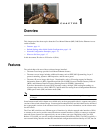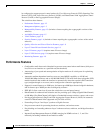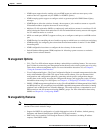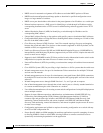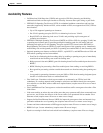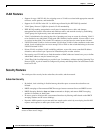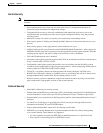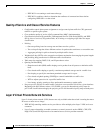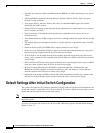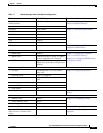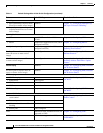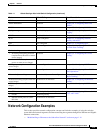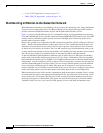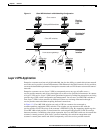
1-8
Cisco ME 3400 Ethernet Access Switch Software Configuration Guide
OL-9639-06
Chapter 1 Overview
Features
–
IEEE 802.1x accounting to track network usage
–
IEEE 802.1x readiness check to determine the readiness of connected end hosts before
configuring IEEE 802.1x on the switch
Quality of Service and Class of Service Features
• Configurable control-plane queue assignment to assign control plane traffic for CPU-generated
traffic to a specific egress queue.
• Cisco modular quality of service (QoS) command-line (MQC) implementation
• Classification based on IP precedence, Differentiated Services Code Point (DSCP), and IEEE
802.1p class of service (CoS) packet fields, ACL lookup, or assigning a QoS label for output
classification
• Policing
–
One-rate policing based on average rate and burst rate for a policer
–
Two-color policing that allows different actions for packets that conform to or exceed the rate
–
Aggregate policing for policers shared by multiple traffic classes
• Weighted tail drop (WTD) as the congestion-avoidance mechanism for managing the queue lengths
and providing drop precedences for different traffic classifications
• Table maps for mapping DSCP, CoS, and IP precedence values
• Queuing and Scheduling
–
Shaped round robin (SRR) traffic shaping to mix packets from all queues to minimize traffic
burst
–
Class-based traffic shaping to specify a maximum permitted average rate for a traffic class
–
Port shaping to specify the maximum permitted average rate for a port
–
Class-based weighted queuing (CBWFQ) to control bandwidth to a traffic class
–
WTD to adjust queue size for a specified traffic class
–
Low-latency priority queuing to allow preferential treatment to certain traffic
• Per-port, per-VLAN QoS to control traffic carried on a user-specified VLAN for a given interface.
Beginning with IOS software release 12.2(25)SEG, you can use hierarchical policy maps for
per-VLAN classification and apply the per-port, per-VLAN hierarchical policy maps to trunk ports.
Layer 2 Virtual Private Network Services
Layer 2 virtual private network (VPN) features are only available when the switch is running the metro
IP access or metro access image.
• IEEE 802.1Q tunneling enables service providers to offer multiple point Layer 2 VPN services to
customers
• Layer 2 protocol tunneling to enable customers to control protocols such as BPDU, CDP, VTP,
PAgP, LACP, and UDLD protocols to be tunneled across service-provider networks.




